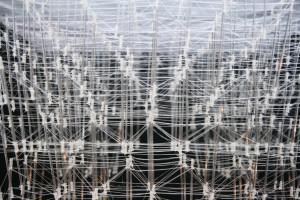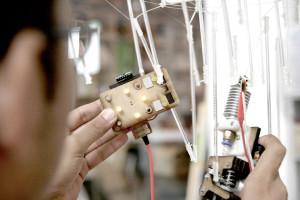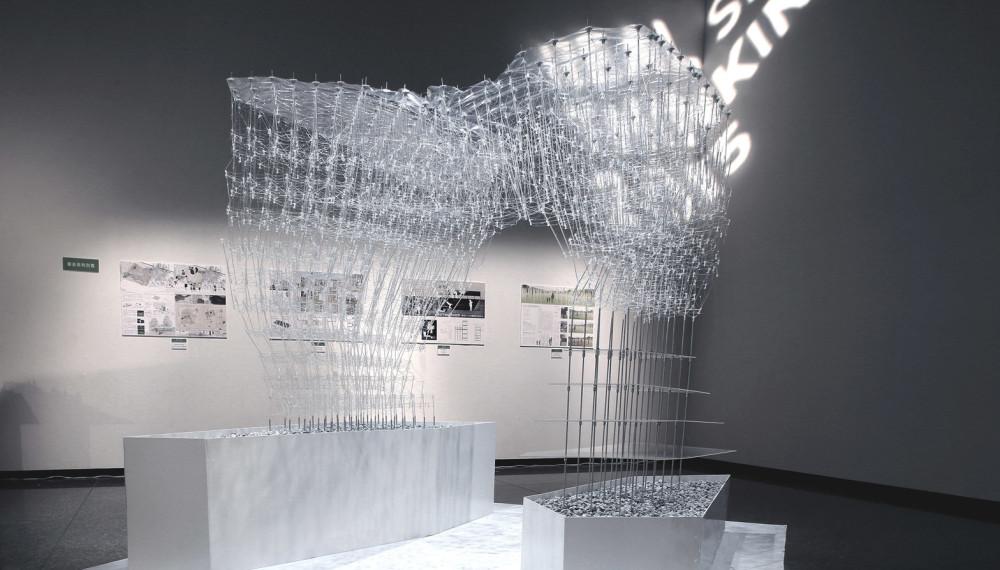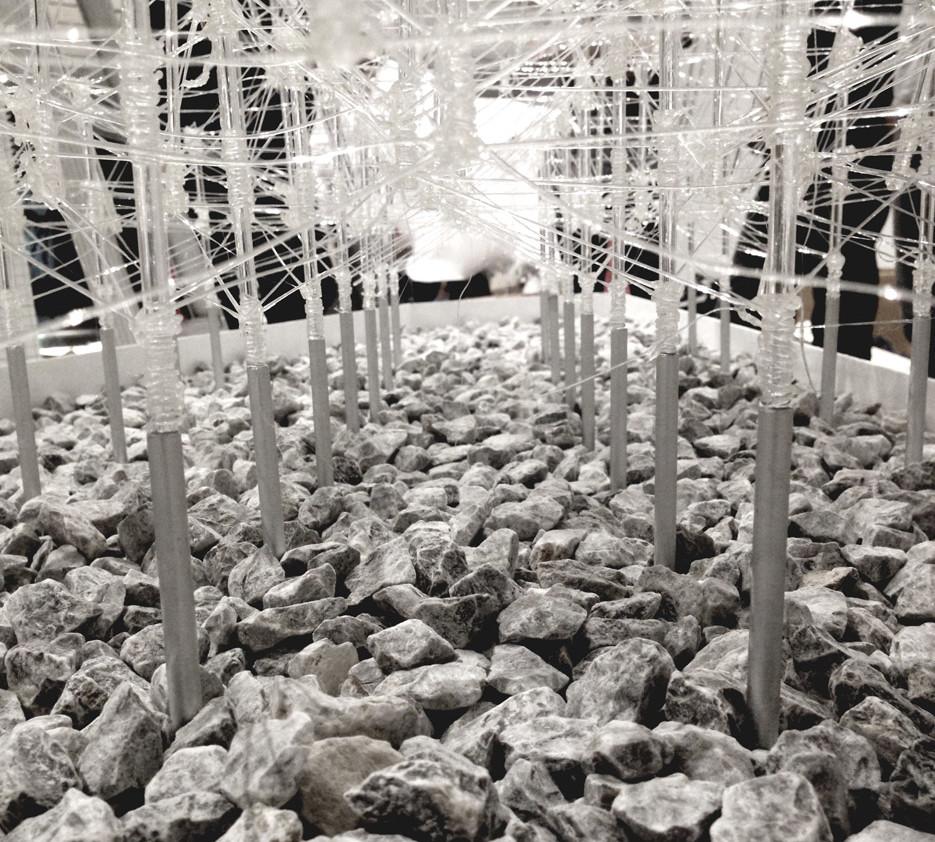While there are several large-scale construction 3D printers being developed, none of them could really be called elegant or graceful. Mostly these huge machines print utilitarian shapes out in concrete materials that need to be smoothed and considerably altered. They certainly will have their uses in the future of construction, but they probably won’t be 3D printing large and beautiful architectural structures any time soon. Any 3D printers that are capable of more delicate structures tend to be limited to a specific printing envelope that are incapable of constructing large-scale architectural pieces.
However a new project being developed at the University of Tokyo is producing incredible and complex architectural structures by thinking outside of the printing envelope. Specifically, the three-dimensional structures are made literally by having no printing envelope thanks to a 3D printing pen that has been modified to work with the user to create precise and stable structures only using extruded plastic. The Tokyo students call them “large-scale hand-drawn structures” and they are made by manually connecting acrylic rods with strings of thermoplastic filament that are guided into place using a custom designed digital tracking system.
Due to the temperature of the pen, the acrylic rods and the plastic filament bond together virtually instantly and can be used to create large structures that offer excellent stability. The structures remain stable thanks to the tension of the plastic filament holding the acrylic rods firmly in place. Because the plastic threads are drawn with a 3D printing pen, the user has more control over the actual fabrication process and can adjust or add to the design based on their own aesthetic desires, or if they feel that the structure needs additional stability. The process adds a level of human instinct to new, digital construction technologies that the design team believes can enhance the process.
“Technology has traditionally been used to automate and replace human labour. The issue with this approach is that it fails to take advantage of human intuition during fabrication. We believe our approach can bridge the current dichotomy between machine and human-made production,” design team member Kevin Clement told Dezeen.
So far the largest structure that the students have assembled is a pavilion that was constructed at the Ozone Gallery in Shinjuku, northwest Tokyo. The 3D tracking system monitored the construction in real time and guided the team member who was using the hand-held 3D printer. While it is similar to a standard 3D printing pen, the one developed by the team is considerably more advanced and closer to the type of extruder typically found on a desktop 3D printer. User interaction is vital to this 3D printing process because of the size of the constructs, which can take on some very complex and intricate shapes.
“What makes this system interesting for us is that the shape can be modified to match different site conditions, and it is simple to add or subtract members to the construct, allowing it to grow and adapt to user preferences. The ease of drawing together the members means that anyone can participate in the process of making complex forms at full scale,” said Clement.
 The 3D printed architectural forms are only intended to be temporary installations and are not suitable long-term structures and typically last about nine months. However if there is a need the structures can be supported and enhanced by adding extra rods and filament to reinforce weak areas. The 3D printing pen technology also allows users the option of heavily modifying or converting the original constructions into entirely new shapes, allowing the same structure to have multiple uses.
The 3D printed architectural forms are only intended to be temporary installations and are not suitable long-term structures and typically last about nine months. However if there is a need the structures can be supported and enhanced by adding extra rods and filament to reinforce weak areas. The 3D printing pen technology also allows users the option of heavily modifying or converting the original constructions into entirely new shapes, allowing the same structure to have multiple uses.
“Large-scale printers make architectural-scale 3D-printing possible but at large expense, requiring huge gantries and controlled conditions. This means that there’s not much ability for this method to be adaptable to on-site construction processes. For these reasons, the complex formalism embraced by much of the discipline has yet to become applicable to the industry beyond one-off cultural buildings and installations,” Clement continued.
Currently the team is using foundations made with aluminium rods that have been inserted into pre-drilled sheets of plywood. The acrylic rods are inserted and filament is then drawn on top of this simple base, completely disguising it. The foundations can also be hidden with plants or other ground cover, or, as was recently used in the team’s latest prototype, a bed of river stones. The team is currently exploring what the next steps are for their 3D printing process and is going to be testing the construct’s durability under various weather conditions. They are also exploring the possibility of allowing public installations to be continually modified by the visiting public to transform the original structure into something entirely new.
Clement and the rest of the design team work out of the Obuchi Laboratory located at the University of Tokyo. The lab is part of the university’s Global 30 Architecture and Urbanism program that is being headed up by Japanese architect Kengo Kuma, the course director Yusuke Obuchi and the team’s tutor Toshi Kiuchi. The rest of the project group includes the Design and Project Management Team of Kevin Clement, Anders Rod, Ratnar Sam and Gilang Arenza, as well as the Fabrication Team of Chloe Ying Xu, Takahiro Osaka, Haruka Uchida, Christopher Wilkens, Kenneth Larssen Lønning, Nicky Li, Sion Asada, Takeru Kumagai, Alric Lee, Rodrigo Fortes, Saki Uchida. Are you surprised at what they have produced with this technology? Discuss in the Tokyo Students Use 3D Printing Pen forum over at 3DPB.com.
[Source: Dezeen]Subscribe to Our Email Newsletter
Stay up-to-date on all the latest news from the 3D printing industry and receive information and offers from third party vendors.
You May Also Like
Creality Begins Selling HALOT-MAGE S: Setting New Standards in Precision 3D Printing
Creality, a leading innovator in consumer-grade 3D printing technology, proudly introduces the HALOT-MAGE S, the latest breakthrough in high-resolution 3D printing. With its cutting-edge features and user-centric design, the HALOT-MAGE...
Farsoon Showcases Comprehensive 3D Printing Solutions, Automation, and More at TCT Asia
This year’s TCT Asia event showcased just how much the Asian additive manufacturing (AM) market has grown, with Eplus3D’s 64-laser metal 3D printer alone acting as a synecdoche for China’s...
Creality Launches Ender-3 V3 Plus: Bigger CoreXZ for Unprecedented Performance
Embracing a journey of innovation and excellence, Creality’s Ender-3 series has established a distinguished path in the field of 3D printing. From the entry-level Ender-3 V3 SE to the feature-rich...
Laser Wars: Eplus3D Unveils Metal 3D Printer with up to 64 Lasers
Now that the laser wars in the powder bed fusion (PBF) space have, for the most part, moved to China, original equipment manufacturers (OEMs) there are in fierce competition. Eplus3D...







































